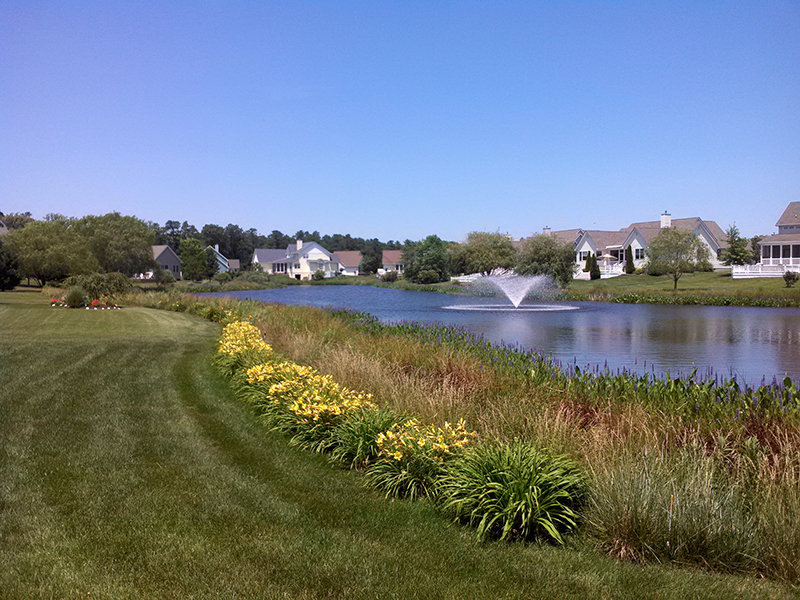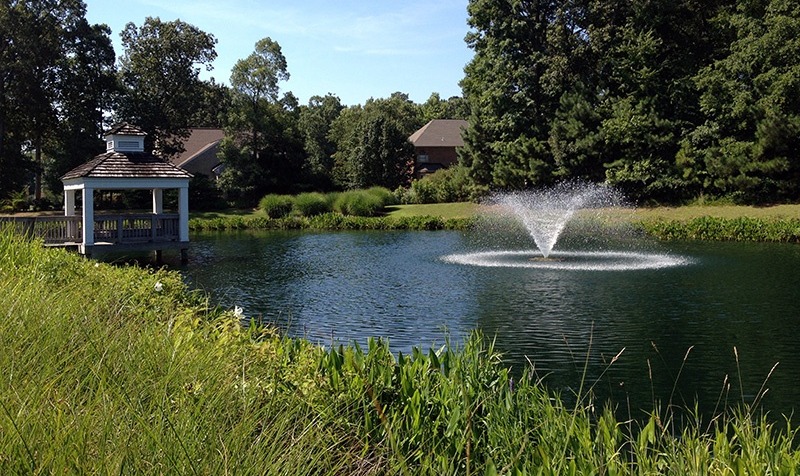

Winter Buffer Trimming and Brush Removal
It is important to take a close look at the vegetative buffer zone that surrounds your waterbody as the winter season approaches. Buffer zones are often an overlooked aspect of pond management and the function of the buffer is significant to the overall health of the pond. When rain water drains through parking lots, streets and then grassy areas, the water will have accumulated a significant amount of nutrients that will lead to pond algae blooms. Without a buffer the water will continue to flow across the grass unimpeded and nutrients will only be filtered by the grass before it reaches the pond. Established tall grasses will do the most effective job of filtering nutrients because they have a strong root system and can sequester nutrients quickly.

Studies have shown that buffers will be most effective at removing nutrients beginning at 3 feet wide and even wider buffers will do a better job at filtering nutrients. A beneficial vegetative buffer should be maintained at 3 feet tall and an annual cutting is recommended to maintain the aesthetic appeal of the pond. If the vegetation is cut too short, it could result in increased nutrient loading in the water that will increase the changes of a future algae bloom in your pond.
A buffer zone can also help prevent shoreline erosion in addition to naturally filtering runoff. Shoreline plants help to stabilize the soil and prevent large amounts of sediment from entering the pond. Excessive runoff of sediment can greatly reduce the waterbody’s depth over time, leading to significant problems that can only be corrected through costly dredging.
The type, size, and location of the vegetation growing in your buffer zone directly impact the overall health of your pond or lake. This time of year, the amount and distribution of the woody vegetation along the shoreline should be considered. Woody vegetation can destabilize banks, dry out the soil, and add large amounts of unwanted nutrients to your waterbody, which can lead to the growth of unwanted aquatic plants. The most common form of woody vegetation found in buffer zones – trees, scrub brush, and woody vegetation – should be managed and removed. These plants can be very difficult to control because of their hardy nature. Many woody plant species slow down their growth and shed leaves this time of year. While woody vegetation can at times be aesthetically pleasing, it can also cause water quality issues.

Winter is the perfect time to consider clearing or cutting back any unwanted shoreline vegetation. Water temperatures are very low and shoreline growth has ceased for the time being, so debris that may fall into your lake or pond will have a limited adverse effects. Keep in mind that even in the winter, every effort should be made to keep cuttings from falling into the pond and sinking to the bottom. An influx of organic matter will result in the potential for future algae blooms as it breaks down and releases utilizable nutrients into the water column. These nutrients are the primary fuel for pond algae growth.
Properly maintained buffer zones can go a long way in helping to prevent problems for your pond. Establishing these buffer zones around the edge of your pond takes very little effort, requires little maintenance, will likely reduce the costs associated with mowing and trimming along the edge of the pond on a weekly basis in the warmer months, and will produce significant beneficial results for your pond.
SOLitude Lake Management is a nationwide environmental firm committed to providing sustainable solutions that improve water quality, enhance beauty, preserve natural resources and reduce our environmental footprint. SOLitude’s team of aquatic resource management professionals specializes in the development and execution of customized lake, pond, wetland and fisheries management programs that include water quality testing and restoration, nutrient remediation, algae and aquatic weed control, installation and maintenance of fountains and aeration systems, bathymetry, mechanical harvesting and hydro-raking, lake vegetation studies, biological assessments, habitat evaluations, and invasive species management. Services and educational resources are available to clients nationwide, including homeowners associations, multi-family and apartment communities, golf courses, commercial developments, ranches, private landowners, reservoirs, recreational and public lakes, municipalities, drinking water authorities, parks, and state and federal agencies. SOLitude Lake Management is a proud member of the Rentokil Steritech family of companies in North America.









